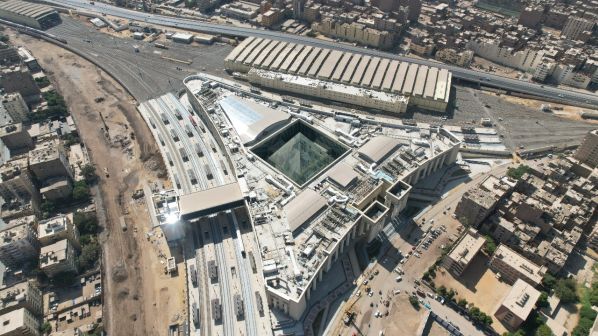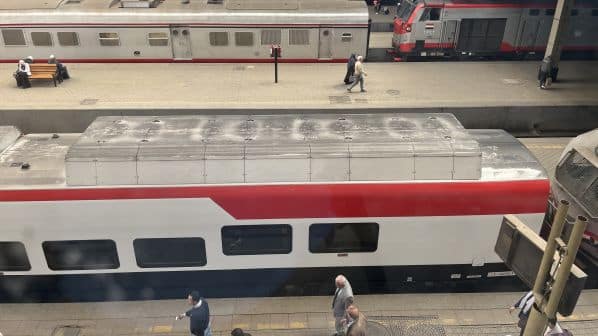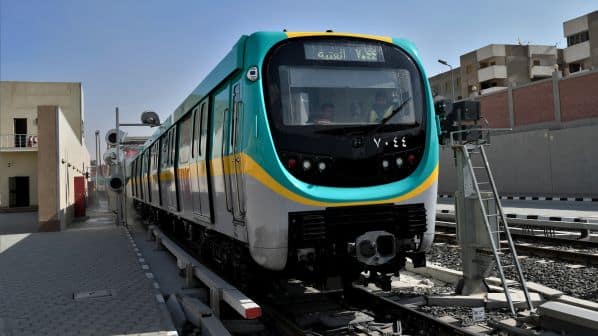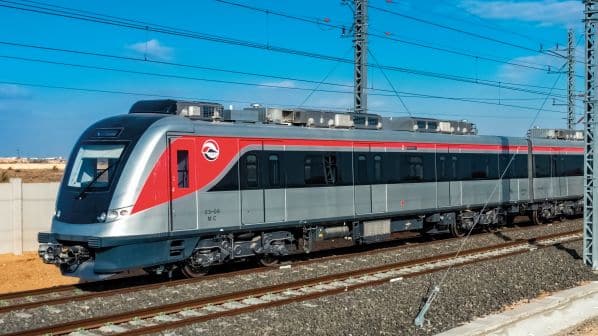CAIRO’s new Bashteel mainline railway station is the country’s largest and arguably most impressive. Located in Giza, to the west of the Nile River, the ornate temple-like building features a 40m-high glass pyramid-shaped roof, a nod to the ancient monuments on the edge of Cairo and the Louvre in Paris.
The new station is expected to open imminently and has capacity for 250,000 passengers per day, occupying a 31,000m² station building on a vast 239ha site. The station features a shopping centre, office buildings and a large multi-story car park. The tracks, platforms and adjacent service buildings and maintenance workshops cover 164ha.
Bashsteel is located in the heart of Greater Cairo, at a major junction for the mainline railways running through the city. The new station will ease the pressure on the Ramses station on the east side of the river, which has handled all mainline trains arriving and departing Cairo, but has become congested.
Bashteel is also an intermodal hub. As well as 10 platforms for mainline rail services to the south and historic sites in Luxor and the Valley of the Kings in Upper Egypt, it is served by metro Line 3, the future West of Nile monorail and bus rapid transit services.
Construction of this multi-functional facility is consistent with the Egyptian government’s vision for the country’s future transport network. “Our objectives are to achieve balance and integration between different means of transport, with a focus on developing the multimodal transport system, and to encourage use of public transport,” says Dr-Eng Tarek Hamed Gewaily, chairman of the National Authority for Tunnels.
These ambitions are apparent in the Egypt Vision 2030 document. Published in February 2016, it outlines the government’s national agenda for a 15-year period. It includes delivering a transport system that achieves sustainable development and “is intrinsically linked with the requirements of future national economic and social development,” while enhancing regional and national transport services.
NAT is playing a central role in this transformation. Initially incorporated in 1983 to execute metro line projects, the scope of NAT was widened in 2018 to include all rail projects involving electrification. NAT is permitted to enter partnerships with other companies and establish its own affiliate companies to operate and maintain its projects.
Under a further change to its status in 2020, NAT transitioned from a public service government entity to an economic entity with the goal of developing revenue streams to support project finance and future maintenance of the projects. “We take income from ticket sales, but also advertising and from the retail areas that will be built at stations,” Gewaily says. “As well as helping to finance our projects, this will help to reduce the cost of tickets and encourage Egyptian people to use this type of transport.”
“Our objectives are to achieve balance and integration between different means of transport.”
Dr Tarek Hamed Gewaily, chairman of the National Authority for Tunnels (NAT)
Gewaily was speaking to IRJ at NAT’s headquarters within the Ministry of Transport building in the centre of the New Administrative Capital (NAC), Egypt’s new capital, construction of which has been underway since 2018 and continues at pace. Indeed, the journey by road to the new capital presents a startling picture of newly-built detached and mostly unoccupied three-storey properties that seem to continue for kilometres. These vast new residential areas are the future suburbs of the NAC, that will serve the new capital to the east and New Cairo to the west.
Cairo has expanded steadily over the past 80 years. The city’s population grew from 1.5 million in 1947 to 6 million in 1986 and now stands at a staggering 22.18 million. At current rates, it could top 38 million by 2050. The government wants to limit this to 30 million and is encouraging people to move away from the centre of the old city to its fringes.
Like all megacities, Cairo suffers from chronic traffic congestion and pollution. Simply crossing the road in the old city is a precarious undertaking. The three-line metro network is efficient, but relatively limited in scope, given the vastness of the city. However several projects to extend the network are underway or planned, which aim to increase ridership to 2 million passengers per day upon completion, up from 1.5 million at present (see panel below).
Admirably, the newly-constructed residential areas are not entirely built around the car. The new East of Nile monorail runs alongside several developments on its journey to the new capital, providing interchange for passengers travelling into the NAC or to New Cairo, where transfer to the metro is possible at Cairo Stadium.
Likewise, the new Capital Train suburban line, dubbed LRT, is also providing the opportunity for residents of new settlements at Badr City, Obour, and El Shorouk to use public transport. The 65km LRT phases 1 and 2 opened in July 2022 and run from Adly Mansour in El Salam City, the northeastern terminus of Cairo metro Line 3 and close to Cairo International Airport, to Arts & Culture City in the centre of NAC. It also includes an 8.5km branch from Badr to Knowledge City in 10th of Ramadan City. The project has been delivered by a consortium of China Railway Engineering (CREC) and Avic International. The line is operated by RATP Dev, which also operates metro Line 3.
The CREC-Avic consortium is also building the 20.4km LRT Phase 3 to the future NAC high-speed station, which includes stops at the future Octagon military complex and Sports City, and the 16.5km Phase 4 extension to the centre of 10th of Ramadan City. Phase 4 will run for 9.3km at-grade and 7.2km elevated. Studies are underway for a 5.5km Phase 5, which will extend the line from the high-speed station to the NAC’s Industrial Zone. A memorandum of understanding (MoU) was signed by NAT and Avic in November to extend the LRT from El Rehab on the future Cairo metro Line 4 by 40km to the NAC monorail station. The line will have eight stations and will serve Rehab, Dar ar Misr El Koronfel, Madinaty, Shorouk, Badr and New Heliopolis. Under the MoU, Avic is expected to submit a technical and financial bid for the project within 12 months. It will be financed by Chinese lending institutions.
The long-distance high-speed network is the centrepiece of Egypt’s rail construction programme. Work is underway on the first two lines totalling 1760km, with a further 225km planned, and 250km under study. These lines will connect Red Sea and Mediterranean ports, while improving connectivity to the south of the country.
“All of the projects are electric and we have to grow this type of transport.”
Tarek Hamed Gewaily
As Gewaily explains, NAT has worked to turn an infrastructure plan into a project pipeline that can produce the highest development impact for the investment made. This is especially true of the new high-speed network, which will revolutionise transport in Egypt by reducing journey times between major population centres and improving country-wide connectivity. It will also provide an extensive commuter network, offering improved access to employment and education to residents of satellite towns and cities, including seven new cities that will be built alongside the route. Use of the network for freight similarly offers the potential for generating economic benefits, with the railway expected to provide a land-based alternative to the Suez Canal.
Another important facet of the plan is the focus on sustainability and reducing CO₂ emissions, which is also in line with the government’s policy goals. “All of the projects are electric and we have to grow this type of transport,” Gewaily says.
While shiny new projects inevitably steal most of the limelight, significant investment is also taking place on Egypt’s existing 5625km non-electrified mainline network. Various signalling and track renewal projects are taking place, while Egyptian National Railways (ENR) is steadily modernising its fleet. Deliveries are underway from orders placed with Talgo of Spain for six locomotive-hauled trains of 15 coaches each and Hungary’s Magyar Vagon for 1300 coaches of several types under a contract originally awarded to Transmashholding in 2018. Talgo is also supplying seven new trains for overnight services, while Škoda Group is refurbishing 280 ENR diesel-electric locomotives under a contract worth more than €1bn that was awarded in June 2023.

Such a wide array of projects is inevitably a boon for employment - the high-speed project is estimated to be employing around 60,000 people - and is one of the main drivers of the government’s megaproject policy. Nevertheless, the sheer volume of construction now underway is placing a significant strain on a limited pool of skilled personnel. Hill International, the project management consultant for the monorail project, requires more than 200 engineers alone. This demand is multiplied significantly across all of the contractors working on projects across all sectors.
While relying extensively on skilled staff from abroad, contractors at work on these projects note Egypt’s strong reputation for producing engineers and say that hiring and working with local people has been a positive experience. There are also efforts to support the development of future talent. Siemens, for example, has a close relationship with several Egyptian universities.
Working with internationally-renowned companies such as Alstom, Siemens, Vinci, Systra and Hill is helping to drive up quality. Gewaily says NAT is cooperating “with a lot of international consultants to help us manage these projects,” which he says is enabling Egypt to adopt international specifications and in turn deliver higher levels of quality assurance and control. He explains that NAT is heavily engaged in each project, closely scrutinising progress by regularly visiting construction sites on at least a monthly basis, and working alongside its partners to solve any problems.
“We follow up on all the projects through daily, weekly, and monthly meetings and updates,” Gewaily says. “We work with all the companies, consultants and construction companies at all levels that are working on the project to identify the obstacles, any issues that might be stopping work, and delays. We push to solve all of these issues to push the project to meet the target date for delivery.”
Inflation
Other challenges are posed by inflation. Egypt has been hit especially hard by a sharp fall in value of its national currency in the past 18 months, which has exposed its dependence on imports. Some contractors note that there is perhaps an over-reliance on imported products and components that domestic industry may have been able to supply for some projects that are currently underway. The speed at which the country is aiming to complete new construction projects has spurred this approach.
Gewaily, however, is not phased by inflation. He points to how Egypt successfully navigated the Covid-19 pandemic and says it is doing the same with the devaluation crisis. “It doesn’t stop anything we are doing,” he says.
In the short-term there is optimism in Egypt that a recent $US 35bn foreign direct investment from the United Arab Emirates (UAE) and a $US 5bn increase in the size of a loan from the International Monetary Fund (IMF) will help to stabilise the situation.

In the medium-term work is underway to develop local industry within Egypt that will support the country’s ongoing construction programme, while fostering economic growth. Gewaily points to the potential presence of Alstom, which is reportedly considering building a new factory in Egypt. In addition, up to 30% of the 40 metro trains that Hyundai Rotem is supplying for the Cairo metro will be manufactured under a partnership with the National Egyptian Railways Industries Company (Neric) at a new plant at East Port Said, part of the Suez Canal economic zone. Talgo will manufacture the seven overnight trains it is supplying at a new plant adjacent to ENR’s depot at Abu Radi.
Egypt is also the home market of internationally-renowned construction companies Orascom and Arab Contractors, which are playing central roles in many of the new railway projects now underway. “In the last five years Egyptian companies have built four tunnels under the Suez Canal and we are now using this local experience on our metro tunnelling projects,” Gewaily says.
Gewaily adds that the development of the high-speed network will not necessarily stop with the first four phases. Indeed, there is a prevailing aspiration within NAT that successful delivery of the Egyptian network could spur wider development in neighbouring countries across the region, with Egypt’s burgeoning rail industry poised to play a leading role.
Looking to the immediate future, Gewaily is bullish on progress. He points to the recent successful openings of the extensions to metro Line 3 as underlining how the projects remain on course. “We are on track and we are completing these projects according to our schedule,” he says.
Certainly, the scale of work is impressive, arguably unparalleled anywhere at the moment. Egypt is undergoing a radical transformation, the country of today is likely to look very different by the end of this decade. It is heartening to see that sustainable rail transport is at the centre of such rapid development.
New Talgo coaches are providing a welcome upgrade on existing mainline rolling stock fleets.
VISITORS to the Pyramids of Giza will soon be able to reach this wonder of the world on the Cairo Metro. The 19km Phase 1 of the new Line 4, which will have 17 stations and runs west from Fustat Park via El Malek El Saleh station, an interchange with the north-south Line 1, will also serve the new Grand Egyptian Museum, which overlooks the pyramids.
Arab Contractors is leading the consortium responsible for civil works. The third of four tunnel boring machines (TBM) began work at the end of February with the project scheduled for completion in 2028. The line is expected to carry 1.2 million passengers per day and NAT is currently tendering a future operations and maintenance contract for Line 4. Mitsubishi is supplying 184 metro cars and railway systems for the line. A future extension from the western terminus at Hadaek El Ashgar south to El Ferdouse is proposed.
Phase 2 of the project is planned to extend the line by 23km and 21 stations east to El Rehab. A study for the project has been completed by the Japan International Cooperation Agency (Jica), which is also providing a Yen 41bn ($US 280m) loan for Phase 1. Phase 2 is expected to serve 800,000 passengers per day.

The latest 6.6km extension of Line 3 from Kit Kat north to Rod al-Farag opened on January 1, adding six new stations. A further 5.1km extension south from Kit Kat to Cairo University is nearing completion and is due to enter service at the end of this year. A further 6.65km underground extension of Line 3, Phase 4C, which will run from the recently expanded Heliopolis station to Cairo International Airport, is proposed.
An upgrade of the existing 21.6km Line 2 is underway. This involves renewal of signalling, power supply systems, and some track. The €614m project is benefitting from €240m of financing from the European Investment Bank (EIB). It will also include the supply of 48 metro trains by Hyundai Rotem. A 7km northern extension of the line to Qalyub is also planned.
A study is similarly taking place to extend metro Line 1 by another 19km north from its terminus at New El Marg to Shebin Al-Qanater. The city’s first metro line opened in 1987 and was extended to 43km in 1989. When completed, the lastest extension will replace the July 23 - Shebin Al-Qanater heavy rail suburban line.
Alstom was awarded a framework agreement in November 2022 to design, construct and maintain the 34km Line 6. This will run north-south from Elkhosos to Tora Al-Balad and the new Maadi area with 26 stations, 12 of which will be underground. Alstom says Line 6 will be Africa’s first driverless metro. It is expected to serve 1.4 million passengers per day and will interchange with lines 1, 3 and 4. Alstom will supply 294 Metropolis metro cars for the project, work on which is yet to begin.
Alexandria
Construction is underway of the 21.7km Alexandria metro, which runs east-west from Abou Qer to Masr station in the north of the city. A €1.3bn contract was awarded by NAT to a consortium of Orascom and Colas Rail, which has a €320m share, in November 2023. The line will serve 20 stations. The contractors will be responsible for the design, supply, installation, testing and commissioning of the track, power supply, signalling, telecommunications, depot equipment and integration of all rail systems. The project is expected to take 30 months to complete.
NAT is seeking an operations and maintenance contractor for the project, which is expected to serve 1.44 million passengers per day when it opens, significantly reducing congestion in the Mediterranean coastal city.
NAT is also tendering for a project to rehabilitate the 13.2km Raml Tram in Alexandria, which first entered service in 1860 and is the oldest in Africa. Work will include grade separation as well as the introduction of updated systems and rolling stock. The project is expected to reduce journey times by half and increase ridership to 132,000 passengers a day. Systra has conducted a preliminary design study in partnership with Egis, ACE and Projacs.

